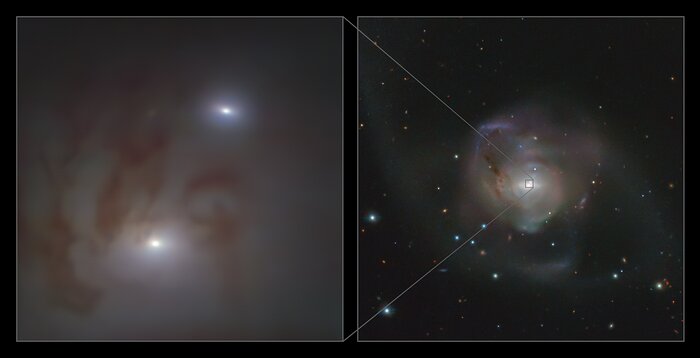Astronomers have discovered a pair of supermassive black holes that are closer to Earth than any previously observed supermassive black hole.
According to a report in The Independent, the two black holes are 89 million light-years away from our planet in the constellation Aquarius, more than 380 light-years closer than the next nearest pair of black holes.
According to a study published in the journal Astronomy & Astrophysics, the cosmic romance was found 89 million light-years away from Earth in the galaxy NGC 7727.

Credit: ESO/Voggel et al.; ESO/VST ATLAS team. Acknowledgement: Durham University/CASU/WFAU
Scientists calculated the mass of each black hole by observing how the gravitational pull of the two black holes affected the movement of neighboring stars. The black holes were discovered to be only 1,600 light-years apart in the sky, according to observations made with the European Southern Observatory’s Very Large Telescope.
According to a statement by Holger Baumgardt, a lecturer at the University of Queensland, these two will eventually combine into “one monster black hole, probably within the next 250 million years.”

Credit:ESO/VST ATLAS team. Acknowledgement: Durham University/CASU/WFAU
The statement further read that This is the first time the masses of a supermassive black hole pair have been measured in this fashion. The team achieved this achievement because of the system’s close closeness to Earth and comprehensive observations collected at the Paranal Observatory in Chile using the Multi-Unit Spectroscopic Explorer (MUSE) on ESO’s VLT, an equipment Voggel learned to operate with during her time as an ESO student. The team was able to determine that the objects in NGC 7727 were truly supermassive black holes by measuring their masses with MUSE and utilizing supplementary data from the NASA/ESA Hubble Space Telescope.
The Independent further reported that these massive gravity wells have very dense masses, which astronomers from France’s Strasbourg Observatory were able to measure by observing how the stars surrounding them were influenced.
The larger black hole has a mass of 154 million suns, while its smaller companion has a mass of 6.3 million suns. However, Business Insider reported, Karine Voggel, a main author on the paper and an astronomer at the Strasbourg Observatory in France, said there is “no cause for fear.”


